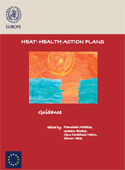Heat–health action plans

Download
Edited by Franziska Matthies, Graham Bickler, Neus Cardeñosa Marín and Simon Hales
2008, x + 45 pages
ISBN 978 92 890 7191 8
CHF 15.00
In developing countries CHF 13.50
Order no. 13400075
Climate change is leading to variations in weather patterns and an apparent increase in extreme weather events, including heat-waves. Recent heat-waves in the WHO European Region have led to a rise in related mortality but the adverse health effects of hot weather and heat-waves are largely preventable. Prevention requires a portfolio of actions at different levels, including meteorological early warning systems, timely public and medical advice, improvements to housing and urban planning and ensuring that health care and social systems are ready to act. These actions can be integrated into a defined heat–health action plan.
This guidance results from the EuroHEAT project on improving public health responses to extreme weather/heat-waves, co-funded by WHO and the European Commission. It explains the importance of the development of heat–health action plans, their characteristics and core elements, with examples from several European countries that have begun their implementation and evaluation.
2008, x + 45 pages
ISBN 978 92 890 7191 8
CHF 15.00
In developing countries CHF 13.50
Order no. 13400075
Climate change is leading to variations in weather patterns and an apparent increase in extreme weather events, including heat-waves. Recent heat-waves in the WHO European Region have led to a rise in related mortality but the adverse health effects of hot weather and heat-waves are largely preventable. Prevention requires a portfolio of actions at different levels, including meteorological early warning systems, timely public and medical advice, improvements to housing and urban planning and ensuring that health care and social systems are ready to act. These actions can be integrated into a defined heat–health action plan.
This guidance results from the EuroHEAT project on improving public health responses to extreme weather/heat-waves, co-funded by WHO and the European Commission. It explains the importance of the development of heat–health action plans, their characteristics and core elements, with examples from several European countries that have begun their implementation and evaluation.



